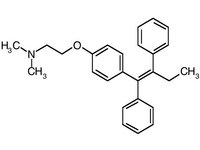Studies of tamoxifen in the prevention of breast cancer have had mixed results. Cuzick and colleagues reviewed data from all available randomized trials to establish the effectiveness of tamoxifen as a prophylactic agent.
They examined data from four large prevention trials that used 20 mg of tamoxifen daily for at least five years plus a trial based on 60 or 120 mg of raloxifene. They also considered trials that used tamoxifen as adjuvant therapy in dosages of 20 to 40 mg daily for at least three years. The five trials included approximately 35,000 women. The nine adjuvant studies included more than 14,000 women, most of whom had estrogen receptor (ER)-positive operable breast cancer.
In the tamoxifen prevention trials, the treated patients showed a 38 percent overall reduction in breast cancer rates. This highly significant reduction was restricted to ER-positive breast cancers. When ER-positive cancers were considered independently, the reduction was 48 percent in tamoxifen-treated women. The reductions were similar in women older than 50 years and in younger women. The single trial of raloxifene reported a 64 percent reduction of breast cancer rates in treated women. Although there was no effect on non-breast-cancer mortality in women treated with tamoxifen, rates of endometrial cancer were increased in all studies of tamoxifen. The relative risk of endometrial cancer was 2.4 in tamoxifen-treated women, with most excess risk occurring in women 50 years or older. The risk of endometrial cancer was not increased in women treated with raloxifene. The number of thromboembolic events was also significantly increased in tamoxifen-treated women (relative risk, 1.9).
The authors conclude that tamoxifen is recommended only for use in women at very high risk of ER-positive cancers. Raloxifene and new agents such as the aromatase inhibitors may provide equal or greater benefit with fewer side effects.
ANNE D. WALLING, M.D.
Cuzick J, et al. Overview of the main outcomes in breast-cancer prevention trials. Lancet January 25, 2003; 361:296-300.
COPYRIGHT 2003 American Academy of Family Physicians
COPYRIGHT 2003 Gale Group



